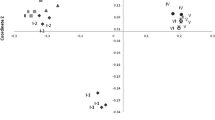Abstract
The distribution patterns of flavonoids hyperoside, isoquercitrin, quercitrin, quercetin, I3,II8-biapigenin and naphtodianthrones hypericin and pseudohypericin were studied in reproductive structures during ontogenetic phase of flowering in Hypericum maculatum Crantz. Considerable differences in the content of these secondary metabolites, in the particular flower parts were found. The content of all the metabolites studied is stable during the whole period of flowering in green flower parts (sepals). In petals, stamens and pistils their content undergoes considerable change associated with the biological functions of particular metabolites. The most conspicuous changes during ontogenetic phase of flowering were the decrease of hyperoside and isoquercitrin content in petals (average content in buds 1.589 mg g−1 dry weight, average content in overblown flowers 0.891 mg g−1 dry weight), the decrease of the I3,II8-biapigenin content in stamens (in buds 1.189 mg g−1 dry weight, in overblown flowers 0.319 mg g−1 dry weight), and the increase of hypericin and pseudohypericin content in both petals (total average content of hypericins in the buds 0.547 mg g−1 dry weight; in overblown flowers 0.792 mg g−1 dry weight) and stamens (in buds 0.189 mg g−1 dry weight; in overblown flowers 0.431 mg g−1 dry weight). Hypericins are absent in the pistil. The flavonoids hyperoside and isoquercitrin, the content of which decreased during ontogenetic phase of flowering, reach the highest contents in the pistil.
Similar content being viewed by others
References
Avato, P. & Guglielmi, G. 2004. Determination of major constituents in St. John’s wort under different extraction conditions. Pharm. Biol. 42: 83–89.
Bagdonaite, E. & Radušiene, J. 2002. Analysis of variation of phenotypical characters in Hypericum maculatum Crantz wild populations. Biologija, pp. 46–49.
Brantner, A., Kartnig, Th. & Ouehenberger, F. 1994. Vergleichende phytochemische Untersuchungen an Hypericum perforatum L. und Hypericum maculatum Crantz. Sci. Pharm. 62: 261–276.
Brockmann, H. & Sanne, W. 1957. Zur Kenntnis des Hypericins und Pseudohypericins. Chem. Ber. 90: 2480–2491.
Ciccarelli, D., Andreucci, A.C. & Pagni, A.M. 2001. The ”black nodules“ of Hypericum perforatum L. subsp. perforatum: morphological, anatomical and histochemical studies during the course of ontogenesis. Israel J. Plant Sci. 49: 33–40.
Geiger, H. 1994. Biflavonoids and triflavonoids, pp. 95–115. In: Harborne, J.B. (ed.), The flavonoids. Advances in research since 1985, Chapman & Hall, London.
Hölzl, J. & Ostrowski, H. 1987. Johanniskraut (Hypericum perforatum L.) HPLC-Analyse der wichtigen Inhaltsstoffe und deren Variabilität in einer Population. Deutsche Apoth.-Ztg., Berlin, 127: 1227–1230.
Hölzl, J. & Petersen, M. 2003. Chemical constituents of Hypericum ssp., pp. 77–93. In: Ernst, E. (ed.), Hypericum. The genus Hypericum. Taylor and Francis, London & New York.
Jacobs, M. & Rubery, P.H. 1988. Naturally occurring auxin transport regulation. Science 241: 346–349.
Kartnig, Th., Heydel, B. & Lässer, L. 1997. Johanniskraut aus Schweizer Arzneipflanzenkultur. Agrarforschung 4: 299–302.
Kaul, R. 2000. Johanniskraut: Botanik, Inhaltsstoffe, Qualitätskontrolle, Pharmakologie, Toxikologie und Klinik. Wiss. Verl.-Ges., Stuttgart, 187pp.
Kireeva, T.B., Sharanov, U.L. & Letchamo, W. 1999. Biochemical and eco-physiological studies on Hypericum spp., pp. 467–468. In: Janick, J. (ed.), Perspectives on new crops and new uses, ASHS Press, Alexandria.
Kitanov, G.M. 2001. Hypericin and pseudohypericin in some Hypericum species. Biochem. Syst. Ecol. 29: 171–178.
Kment, V., Pěnková, I. & Starý, F. 1990. Matečné rostliny drogy Herba hyperici. Českosl. Farm. 39: 323–326.
Leifertová, I. 1966. Studium flavonoidů v československých druzích rodu Hypericum. Preslia 38: 386–390.
Maleš, Z., Plazibat, M., Vundać, V. B., Zuntar, I. & Pilepić, K.H. 2004. Thin-layer chromatographic analysis of flavonoids, phenolic acids, and amino acids in some Croatian Hypericum taxa. J. Plan. Chromatogr. 17: 280–285.
Mártonfi, P. & Repčák, M. 1994. Secondary metabolites during flower ontogenesis of Hypericum perforatum L. Zahradnictví 21: 37–44.
Mártonfi, P., Repčák M. & Mihoková, L. 1996. Hypericum maculatum Crantz subsp. maculatum × H. perforatum L. (Hypericaceae): Corroboration of natural hybridization by secondary metabolite analysis. Folia Geobot. Phytotax. 31: 245–250.
Mártonfi, P., Repčák, M., Ciccarelli, D. & Garbari, F. 2001. Hypericum perforatum L. — chemotype without rutin from Italy. Biochem. Syst. Ecol. 29: 659–661.
Michaluk, A. 1961. Badania nad flavonoidami w gatunkach rodzaju Hypericum II. Diss. Pharm. 13: 73–79.
Onelli, E., Rivetta, A., Giorgi, A., Bignami, M., Cocucci, M. & Patrignani, G. 2002. Ultrastructural studies on the developing secretory nodules of Hypericum perforatum. Flora 197: 92–102.
Pietta, P., Gardana, C. & Pietta, A. 2001. Comparative evaluation of St. John’s wort from different Italian regions. Farmaco 56: 491–496.
Radušiene, J. & Bagdonaite, E. 2002. Phenotypic variation in Hypericum perforatum L. and H. maculatum Crantz wild populations in Lithuania. J. Herbs Spices Med. Plants 9: 345–351.
Repčák, M. & Mártonfi, P. 1997. The localization of secondary substances in Hypericum perforatum flower. Biologia, Bratislava 52: 91–94.
Robson, N.K.B. 2002. Studies in the genus Hypericum L. (Guttiferae) 4(2). Section 9. Hypericum sensu lato (part 2): subsection 1. Hypericum series 1. Hypericum. Bull. Nat. Hist. Mus. London, Bot. 32: 61–123.
Seidler-Łozykowska, K. 2003. Secondary metabolites content of Hypericum sp. in different stages and plant parts, pp. 100–105. In: Ernst. E. (ed.): Hypericum. The genus Hypericum. Taylor and Francis, London & New York.
Seidler-Łozykowska, K., Dabrowska, J. & Zygmunt, B. 1999. Content of active substances in herb of St. John’s wort (Hypericum perforatum L.) cvar. Topaz in different vegetation phases. Herba Pol. 45: 169–172.
Sirvent, T.M., Walker, L., Vance, N. & Gibson, D.M. 2002. Variation in hypericins from wild populations of Hypericum perforatum L. in the Pacific Northwest of the U.S.A. Econ. Bot. 56: 41–48.
Southwell, I.A., & Bourke, C.A. 2001. Seasonal variation in hypericin content of Hypericum perforatum L. (St. John’s wort). Phytochem. 56: 437–441.
Tekel’ová, D., Repčák, M., Zemková, E. & Tóth, J. 2000. Quantitative changes of dianthrones, hyperforin and flavonoids content in the flower ontogenesis of Hypericum perforatum. Planta Med. 66: 778–780.
Umek, A., Kreft, S., Kartnig, Th. & Heydel, B. 1999. Quantitative phytochemical analyses of six Hypericum species growing in Slovenia. Planta Med. 65: 388–390.
Vogt, T. & Taylor, L.P. 1995. Flavonol 3-O-glycosyltransferases associated with Petunia pollen produce gametophyte-specific flavonol diglycosides. Plant Physiol. 108: 903–911.
Walker, L., Sirvent, T., Gibson, D. & Vance, N. 2001. Regional differences in hypericin and pseudohypericin concentrations and five morphological traits among Hypericum perforatum plants in the northwestern United States. Can. J. Bot. 79: 1248–1255.
Ylstra, B., Touraev, A., Benito Moreno, R.M., Stöger, E., van Tunen, A.J., Vicente, O., Mol, J.N.M. & Heberle-Bors, E. 1992. Flavonols stimulate development, germination, and tube growth of tobacco pollen. Plant Physiol. 100: 902–907.
Author information
Authors and Affiliations
Rights and permissions
About this article
Cite this article
Mártonfi, P., Repčák, M. & Mártonfiová, L. Secondary metabolites during ontogenetic phase of reproductive structures in Hypericum maculatum . Biologia 61, 473–478 (2006). https://doi.org/10.2478/s11756-006-0079-8
Received:
Accepted:
Issue Date:
DOI: https://doi.org/10.2478/s11756-006-0079-8




